The whole family had a great time and I was surprised that everyone really got into the Brunmeier Christmas Olympics. My cousin, Elisabeth, and I split the family into three teams and put together a series of competitions. Winner took home the title and the losers had to be the kitchen work crew for the Christmas dinner.
Friday, December 28, 2007
Christmas in the Rocky Mountains
My Aunt hit a homerun this year by suggesting that we do something different for the holidays to lighten the spirit of the family after the tragedy of this fall. She stumbled upon Trail Creek Ranch, about 20 miles Northwest of Red Feathers, CO. (Or 60 miles south of Laramie, WY). During the summer Trail Creek hosts a working dude ranch and trout fishing from the Poudre River that runs through the property. During the winter, it is a beautiful winter wonderland.
something different for the holidays to lighten the spirit of the family after the tragedy of this fall. She stumbled upon Trail Creek Ranch, about 20 miles Northwest of Red Feathers, CO. (Or 60 miles south of Laramie, WY). During the summer Trail Creek hosts a working dude ranch and trout fishing from the Poudre River that runs through the property. During the winter, it is a beautiful winter wonderland.
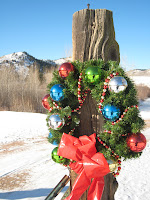 The main ranch house, originally built in the late 1800's, used to be a main stop on the trail from Denver to Laramie before the highways were built. With 8 bedrooms, it was the perfect place to host the Brunmeier Christmas Retreat. There was even a "house horse" that hung out near the main house and quickly became friends with the entire family.
The main ranch house, originally built in the late 1800's, used to be a main stop on the trail from Denver to Laramie before the highways were built. With 8 bedrooms, it was the perfect place to host the Brunmeier Christmas Retreat. There was even a "house horse" that hung out near the main house and quickly became friends with the entire family.
The whole family had a great time and I was surprised that everyone really got into the Brunmeier Christmas Olympics. My cousin, Elisabeth, and I split the family into three teams and put together a series of competitions. Winner took home the title and the losers had to be the kitchen work crew for the Christmas dinner.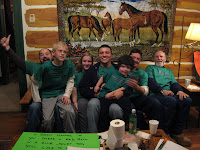 I have to say congrats to the "Red Necks" who took the crown and the title of the "Winter Retreat Elite" and I send my regrets to the "Lean Mean Fighting Green Bean Dream Team" who were the Kitchen Work Crew. As for the Blue Jackets, better luck next year! It was a close race! I will never forget the scene the family made while playing the game "Bundle Up," which involved covering a person in as many extra items of clothing as physically possible in a certain amount of time. I laughed so hard watching everyone scramble for clothes and winter gear that I thought I forget how to breathe.
I have to say congrats to the "Red Necks" who took the crown and the title of the "Winter Retreat Elite" and I send my regrets to the "Lean Mean Fighting Green Bean Dream Team" who were the Kitchen Work Crew. As for the Blue Jackets, better luck next year! It was a close race! I will never forget the scene the family made while playing the game "Bundle Up," which involved covering a person in as many extra items of clothing as physically possible in a certain amount of time. I laughed so hard watching everyone scramble for clothes and winter gear that I thought I forget how to breathe.
 Hopefully, I will have all the photos up after the New Year... (as well as other photos from this past year.) In the meantime, I hope everyone has a merry holiday season and I send all the best to you this new year!
Hopefully, I will have all the photos up after the New Year... (as well as other photos from this past year.) In the meantime, I hope everyone has a merry holiday season and I send all the best to you this new year!
The whole family had a great time and I was surprised that everyone really got into the Brunmeier Christmas Olympics. My cousin, Elisabeth, and I split the family into three teams and put together a series of competitions. Winner took home the title and the losers had to be the kitchen work crew for the Christmas dinner.
Saturday, April 28, 2007
Friday, April 27, 2007
My May Mission: Springtime In Europe
6 Countries, 8 Cities, 2 Conferences, 1 Wedding... 12 Days.
For someone whose only experience of European travel has been limited to the United Kingdom, a task such as this is both exciting and daunting, at the same time. It challenges the possibility of one's abilities to grasp the true nature and culture of a city in 24 hours or less. But given this unique opportunity to see places I have only been able to dream about, it was too much of a temptation to resist... especially when the travel is partially funded by a departmental grant.
So to quote Mark Twain, it is time to "...throw off the bowlines. Sail away from the safe harbor. Catch the trade winds in your sails. Explore. Dream. Discover."
A Detailed European Itinerary
As my Mom requested that I send her a detailed itinerary of my travels, and I think its a brilliant idea to keep family&friends up to date on my plans, I thought I post my detailed itinerary with fun links (in color). Hopefully, I will have time to find an internet cafe to update it while traveling. Feel free to comment and add suggestions of things i should try to see along the way!
27 APR: San Francisco/New York City
Flight Info: American Airlines FLT178
Departs: SFO @ 1:15PM
Arrives: JFK @ 9:45PM
Lodgings: Uncle Charlie Flat in Queens
08:30am - Team Meeting @ Office
10:30am - BART from Berkeley to SFO Airport
12:00pm - Check-In: American Airlines FLT 178
09:45pm - Arrive JFK
10:15pm - Check Luggage: British Airways
10:30pm - JFK Airport Pick-Up (Uncle Charlie)
10:45pm - Late Dinner with Family
28 APR: New York City (USA) /London (England)
Flight Info: British Airways FLT182
Departs: JFK @ 10:45pm
Lodgings: British Airways FLT182
08:00am - Coffee & Bagel @ Dean & DeLuca, Rockefeller Center
10:15am - Presentation (Evolution of Mayan Language) @ AMNH
12:15pm - Lunch & Tour @ The Metropolitan Museum of Art
02:30pm - Wanderings & Early Dinner Mid-Town
6:30pm - Shuttle to JFK @ Grand Central Station
7:30pm - Check-In: British Airways FLT182
29 APR: London (England)
Flight Info: British Airways FLT182
Arrives: Heathrow @ 10:30am
Lodgings: Astor Museum Inn
10:30am - Arrive Heathrow
12:00pm - Tube from Heathrow to Astor Museum Inn
01:00pm - Check In: Astor Museum Inn
03:00pm - Tour @ The British Museum
07:00pm - Dinner & Tour with UCL Institute of Archaeology
30 APR: Cambridge/London (England)
Lodgings: Astor Museum Inn
07:00am - Rail from London to Cambridge
08:30am - Breakfast & Check-In
09:15am - Conference Presentations
11:15am - Presentation @ The Cambridge Museum of Archeology & Anthropology
12:30pm - Lunch @ King's College & Tour of Chapel
01:15pm - Conference Presentations
04:00pm - Rail from Cambridge to London
07:30pm - Orchestra Stalls Seating (E24) - Les Miserables
1 MAY: London (England)/Paris (France)
Rail Info: Eurostar #9036
Departs: Waterloo (London) @ 3:11PM
Arrives: Gare Du Nord (Paris) @ 6:53PM
Lodgings: Le Regent Montmarte
08:00am - Self-Guided Walking Tour of London
12:30pm - Check Out: Astor Inn
02:15pm - Check-In: Eurostar #9036
07:00pm - Arrive: Gare Du Dord (Paris)
07:30pm - Check-In: Le Regent Montmarte
08:30pm - Self-Guided Night Walk & Dinner
2 May: Paris (France)
Lodgings: Le Regent Montmarte
A DAY IN PARIS!
3 May: Paris (France) /Stockholm (Sweden)
Flight Info: Scandinavian Airlines SK574
Depart: Charles De Gaulle Apt (Paris) @ 10:40am
Arrive: Arlanda Apt (Stockholm) @ 01:10pm
Lodgings: Ellen's Flat
07:00am - Check-Out: Le Regent Montmarte
07:30am - Metro from Gare Du Nord to CDG-Roissy (B3)
08:30am - Check-In: Scandinavian Airlines SK574
01:00pm - Arrive: Arlanda Apt (Stockholm)
02:00pm - Rail from Arlanda to Downtown Stockholm
02:30pm - Settle in @ Ellen's Flat
03:00pm - Henrik's Walking Tour of Stockholm and Dinner
4 May: Stockholm/Kristianstad (Sweden)
Rail Info: SJ Rail X 2000 521
Depart: Stockholm C Station @ 6:20am
Arrive: Kristianstad C Station @ 10:41am
Lodgings: First Hotel Christian IV, Kristianstad
06:00am - Arrive Stockholm C Rail Station
11:00am - Arrive Kristianstad C Rail Station
11:30am - Early Check-In: First Hotel Christian IV
12:3opm - Lunch w/ Other Wedding Guests
02:00pm - Tove's Walking Tour of Kristianstad
5 May: Kristianstad/Bäckaskogslott (Sweden)
Lodgings: Bäckaskogslott (The Bäckaskog Castle)
09:00am - Breakfast w/ Wedding Guests
10:00am - Check-Out: First Hotel Christian IV
12:00pm - Check-In: Bäckaskogslott (The Bäckaskog Castle)
Tonio & Tove's Wedding & Reception
www.mywedding.com/tovetonio/
6 May: Bäckaskogslott/Kristianstad (Sweden) /
Copenhagen (Denmark) /Cologne-Bonn (Germany)
Rail Info: SJ Öresundståg 1031
Depart: Kristianstad C Rail Station @ 07:17am
Arrive: Kobenhavn H Rail Station @ 09:17am
Flight Info: Scandinavia Airlines SK641
Depart: Copenhagen Kastrup Airport @ 05:00pm
Arrive: Cologne/Bonn Airport @ 06:20pm
Lodgings: Vivien's Flat in Bonn
06:30am - Check-Out: Bäckaskogslott
07:00am - Arrive Kristianstad C Rail Station
09:30am - Arrive Copenhagen H Rail Station
10:00am - Boat/Canal Tour of Copenhagan
11:15 am - Walking Tour of Copenhagen
01:00pm - Lunch @ Cafeen Nikolaj
02:30pm - Take Rail to Kastrup Airport
03:00pm - Check-In: Scandinavia Airlines SK641
06:30pm - Arrive: Cologne /Bonn Airport
07:30pm - Meet Vivien @ Baggage Claims
7 May: Bonn (Germany)
Lodgings: Vivien's Flat
Tour of Bonn with Vivien!!
8 May: Bonn (Germany)
Lodgings: Vivien's Flat
09:oo am - Explore Bonn
11:00 am - Visit the Kunst- und Ausstellungshalle der Bundesrepublik Deutschland (Art and Exhibition Hall of the Federal Republic of Germany) in Bonn showcasing the exhibition "Egypt’s Sunken Treasures”
5:oo pm - Dinner w/ Vivien
9 May: Bonn (Germany)/London (England)/San Francisco (USA)
Rail Info: Germany InterCity Express Rail
Depart: Bonn @ 07:30am
Arrive: Frankfurt Airport @ 08:30am
Flight Info: British Airways Flt903
Depart: Frankfurt Airport @ 11:20am
Arrive: Heathrow (London) @ 12:00pm
Flight Info: British Airways FLT287
Depart: Heathrow (London) @ 01:50pm
Arrive: San Francisco @ 04:40pm
27 APR: San Francisco/New York City
Flight Info: American Airlines FLT178
Departs: SFO @ 1:15PM
Arrives: JFK @ 9:45PM
Lodgings: Uncle Charlie Flat in Queens
08:30am - Team Meeting @ Office
10:30am - BART from Berkeley to SFO Airport
12:00pm - Check-In: American Airlines FLT 178
09:45pm - Arrive JFK
10:15pm - Check Luggage: British Airways
10:30pm - JFK Airport Pick-Up (Uncle Charlie)
10:45pm - Late Dinner with Family
28 APR: New York City (USA) /London (England)
Flight Info: British Airways FLT182
Departs: JFK @ 10:45pm
Lodgings: British Airways FLT182
08:00am - Coffee & Bagel @ Dean & DeLuca, Rockefeller Center
10:15am - Presentation (Evolution of Mayan Language) @ AMNH
12:15pm - Lunch & Tour @ The Metropolitan Museum of Art
02:30pm - Wanderings & Early Dinner Mid-Town
6:30pm - Shuttle to JFK @ Grand Central Station
7:30pm - Check-In: British Airways FLT182
29 APR: London (England)
Flight Info: British Airways FLT182
Arrives: Heathrow @ 10:30am
Lodgings: Astor Museum Inn
10:30am - Arrive Heathrow
12:00pm - Tube from Heathrow to Astor Museum Inn
01:00pm - Check In: Astor Museum Inn
03:00pm - Tour @ The British Museum
07:00pm - Dinner & Tour with UCL Institute of Archaeology
30 APR: Cambridge/London (England)
Lodgings: Astor Museum Inn
07:00am - Rail from London to Cambridge
08:30am - Breakfast & Check-In
09:15am - Conference Presentations
11:15am - Presentation @ The Cambridge Museum of Archeology & Anthropology
12:30pm - Lunch @ King's College & Tour of Chapel
01:15pm - Conference Presentations
04:00pm - Rail from Cambridge to London
07:30pm - Orchestra Stalls Seating (E24) - Les Miserables
1 MAY: London (England)/Paris (France)
Rail Info: Eurostar #9036
Departs: Waterloo (London) @ 3:11PM
Arrives: Gare Du Nord (Paris) @ 6:53PM
Lodgings: Le Regent Montmarte
08:00am - Self-Guided Walking Tour of London
12:30pm - Check Out: Astor Inn
02:15pm - Check-In: Eurostar #9036
07:00pm - Arrive: Gare Du Dord (Paris)
07:30pm - Check-In: Le Regent Montmarte
08:30pm - Self-Guided Night Walk & Dinner
2 May: Paris (France)
Lodgings: Le Regent Montmarte
A DAY IN PARIS!
3 May: Paris (France) /Stockholm (Sweden)
Flight Info: Scandinavian Airlines SK574
Depart: Charles De Gaulle Apt (Paris) @ 10:40am
Arrive: Arlanda Apt (Stockholm) @ 01:10pm
Lodgings: Ellen's Flat
07:00am - Check-Out: Le Regent Montmarte
07:30am - Metro from Gare Du Nord to CDG-Roissy (B3)
08:30am - Check-In: Scandinavian Airlines SK574
01:00pm - Arrive: Arlanda Apt (Stockholm)
02:00pm - Rail from Arlanda to Downtown Stockholm
02:30pm - Settle in @ Ellen's Flat
03:00pm - Henrik's Walking Tour of Stockholm and Dinner
4 May: Stockholm/Kristianstad (Sweden)
Rail Info: SJ Rail X 2000 521
Depart: Stockholm C Station @ 6:20am
Arrive: Kristianstad C Station @ 10:41am
Lodgings: First Hotel Christian IV, Kristianstad
06:00am - Arrive Stockholm C Rail Station
11:00am - Arrive Kristianstad C Rail Station
11:30am - Early Check-In: First Hotel Christian IV
12:3opm - Lunch w/ Other Wedding Guests
02:00pm - Tove's Walking Tour of Kristianstad
5 May: Kristianstad/Bäckaskogslott (Sweden)
Lodgings: Bäckaskogslott (The Bäckaskog Castle)
09:00am - Breakfast w/ Wedding Guests
10:00am - Check-Out: First Hotel Christian IV
12:00pm - Check-In: Bäckaskogslott (The Bäckaskog Castle)
Tonio & Tove's Wedding & Reception
www.mywedding.com/tovetonio/
6 May: Bäckaskogslott/Kristianstad (Sweden) /
Copenhagen (Denmark) /Cologne-Bonn (Germany)
Rail Info: SJ Öresundståg 1031
Depart: Kristianstad C Rail Station @ 07:17am
Arrive: Kobenhavn H Rail Station @ 09:17am
Flight Info: Scandinavia Airlines SK641
Depart: Copenhagen Kastrup Airport @ 05:00pm
Arrive: Cologne/Bonn Airport @ 06:20pm
Lodgings: Vivien's Flat in Bonn
06:30am - Check-Out: Bäckaskogslott
07:00am - Arrive Kristianstad C Rail Station
09:30am - Arrive Copenhagen H Rail Station
10:00am - Boat/Canal Tour of Copenhagan
11:15 am - Walking Tour of Copenhagen
01:00pm - Lunch @ Cafeen Nikolaj
02:30pm - Take Rail to Kastrup Airport
03:00pm - Check-In: Scandinavia Airlines SK641
06:30pm - Arrive: Cologne /Bonn Airport
07:30pm - Meet Vivien @ Baggage Claims
7 May: Bonn (Germany)
Lodgings: Vivien's Flat
Tour of Bonn with Vivien!!
8 May: Bonn (Germany)
Lodgings: Vivien's Flat
09:oo am - Explore Bonn
11:00 am - Visit the Kunst- und Ausstellungshalle der Bundesrepublik Deutschland (Art and Exhibition Hall of the Federal Republic of Germany) in Bonn showcasing the exhibition "Egypt’s Sunken Treasures”
5:oo pm - Dinner w/ Vivien
9 May: Bonn (Germany)/London (England)/San Francisco (USA)
Rail Info: Germany InterCity Express Rail
Depart: Bonn @ 07:30am
Arrive: Frankfurt Airport @ 08:30am
Flight Info: British Airways Flt903
Depart: Frankfurt Airport @ 11:20am
Arrive: Heathrow (London) @ 12:00pm
Flight Info: British Airways FLT287
Depart: Heathrow (London) @ 01:50pm
Arrive: San Francisco @ 04:40pm
Wednesday, April 25, 2007
Affordable Europe: City Guides
From: emailthis@ms3.lga2.nytimes.com on behalf of Nancy
Sent: Wed 4/25/2007 3:47 PM
To: Wanderer
Subject: NYTimes.com: Affordable Europe: City Guides
This page was sent to you by: Nancy
Message from sender: i thought you might like this.
TRAVEL April 22, 2007
Affordable Europe: City Guides
Yes, the euro remains strong, but you don’t have to max out your credit card to indulge in some of Europe’s timeless luxuries.
LONDON
PARIS
COPENHAGEN
Sent: Wed 4/25/2007 3:47 PM
To: Wanderer
Subject: NYTimes.com: Affordable Europe: City Guides
This page was sent to you by: Nancy
Message from sender: i thought you might like this.
TRAVEL April 22, 2007
Affordable Europe: City Guides
Yes, the euro remains strong, but you don’t have to max out your credit card to indulge in some of Europe’s timeless luxuries.
LONDON
PARIS
COPENHAGEN
Tuesday, April 24, 2007
Restaurants in Paris
From: Michael Chui
Sent: Tue 4/24/2007 11:58 PM
To: Wanderer
Subject: Paris Suggestions
Vail was really fun. Sunday was one of the best ski days I've had in a long time. Five inches of fresh powder fell on Saturday night, but it was sunny by Sunday, which was awesome. I'm so jealous that you get to traipse around the world.
I do have a few restaurant recommendations from a Lebanese Canadian friend of mine:
Desserts:
LaDuree on the Champs-Elysees
PierreHerme in St-Germain
Regular Food (a.k.a dinner):
Chez Andre on rue Marbeuf
(And my mom suggests the following)
Helene Darroze 01 42 22 00 11 Le Passiflore rue de longchamps
La Duree is a fun place for dessert. Chez Andre is kind of a classic diner. Helene Darroze (very modern decor) and Le Passiflore (classy, classic restaurant) are places you'll want to dress up. Apparently Helene Darroze rates 2 Michelin stars, and Le Passiflore is a single Michelin star
- Chui
Sent: Tue 4/24/2007 11:58 PM
To: Wanderer
Subject: Paris Suggestions
Vail was really fun. Sunday was one of the best ski days I've had in a long time. Five inches of fresh powder fell on Saturday night, but it was sunny by Sunday, which was awesome. I'm so jealous that you get to traipse around the world.
I do have a few restaurant recommendations from a Lebanese Canadian friend of mine:
Desserts:
LaDuree on the Champs-Elysees
PierreHerme in St-Germain
Regular Food (a.k.a dinner):
Chez Andre on rue Marbeuf
(And my mom suggests the following)
Helene Darroze 01 42 22 00 11 Le Passiflore rue de longchamps
La Duree is a fun place for dessert. Chez Andre is kind of a classic diner. Helene Darroze (very modern decor) and Le Passiflore (classy, classic restaurant) are places you'll want to dress up. Apparently Helene Darroze rates 2 Michelin stars, and Le Passiflore is a single Michelin star
- Chui
Monday, April 23, 2007
Thursday, April 19, 2007
Nancy's Advice For Paris
From: Nancy
Sent: Thursday, April 19, 2007 10:46 AM
To: Wanderer
Subject: Advice For Daytripping Paris
Sent: Thursday, April 19, 2007 10:46 AM
To: Wanderer
Subject: Advice For Daytripping Paris
You're spending two nights in Paris? Ooolala! Here are my ideas for sights and things to do.
This first part is actually stuff I did in one day alone:
- The Louvre (especially to see the statues of Winged Victory of Sammothrace, Psyche, and Eros)
- Head across to street to Angelina's to have some hot chocolate (an Audrey Hepburn fave thing to do)
- Maison du chocolat or Debauve & Gallais for delicious chocolates
- Have a delicious lunch or dinner of bagel and some yummy spread in the Jewish Quarter, which I think is on Rue de Rosiers (Le Marais in Paris)
- Spend time in a cafe on Montparnasse, the road of literary giants.
This second part is stuff that I liked which I did over a few days:
- The Sacre Coeur and stroll around Montmartre
- Wander around the Latin Quarter for cheese and pastry and also look at books
- Shopping at Printemps
- Viewing Paris from the top of the Arc de Triomphe
- Go to a bar and listen to jazz
- Rodin Sculpture Garden
- Jardin du Luxembourg
You'll have to be able to navigate yourself on the metro, but it shouldn't be too difficult. Things are probably more expensive now than when I went...which was when the dollar was greater than the euro. Let me know if you need anything else!
-n
Wednesday, April 18, 2007
Henrik's Recommended Walking Tour Of Stockholm (Sweden)
 From: Henrik
From: HenrikSent: Wednesday, April 18, 2007 12:29 AM
To: Wanderer
Subject: Re: Travel advice...
Let's definitely talk before you leave for Europe! A couple of ideas though for your stay in Stockholm...
 You want to take a walk through the "Gamla Stan" = "Old city" which is the middle of the city. Walk down the "Västerlånggatan" street where you'll find a ton of touristy shops, but also some nice cafes. Be sure to wander off in some of the alleyways that start from the "Västerlånggatan" - supposedly one of these alleys is recognized as the worlds narrowest street. If you're close to the royal castle around 12 noon it may be worthwhile seeing the changing of the guards (although this will be a Thursday, so it won't be the full deal that you'd see on a Saturday or Sunday.
You want to take a walk through the "Gamla Stan" = "Old city" which is the middle of the city. Walk down the "Västerlånggatan" street where you'll find a ton of touristy shops, but also some nice cafes. Be sure to wander off in some of the alleyways that start from the "Västerlånggatan" - supposedly one of these alleys is recognized as the worlds narrowest street. If you're close to the royal castle around 12 noon it may be worthwhile seeing the changing of the guards (although this will be a Thursday, so it won't be the full deal that you'd see on a Saturday or Sunday.From "Slussen" (south end of "Gamla Stan") you can take a ferry boat out to the "Djurgården" peninsula (schedule at http://www.waxholmsbolaget.se, click on UK flag at top right for English) . Out there you'll find "Skansen" which is a park that has full size buildings collected from all over Sweden from different time periods, which I think the archaeologist in you might find interesting. "Skansen" is also a Zoo, but that part is less interesting. You're also very close to the "Vasa", a battle ship that sunk on it's maiden voyage in the 1600's. It was recovered in the 1960's and is in an amazingly good condition.
If you then proceed across the "Djurgårdsbron" bridge to the "Strandvägen" boardwalk you have an easy 20-25 minute walk till you get to the downtown shopping areas of Stockholm. It's worth taking a look at "NK", a major department store, that has been around for over 100 years.
I guess you'll spend Thu night in Stockholm - for a nice relaxed drink its nice to go down to the "Mariatorget" square in the "Södermalm" part of town. Here you'll find plenty of nice pubs and bars that have a fairly relaxed atmosphere. For a slightly more "posh" area of town you can go to the "Stureplan" square, just north of the central shopping district. This is more of the banker & consultant type setting, but there are some nice bars around here too.
A good web site to visit is http://www.visit-stockholm.com/ which has lots of info, and some good maps (print one and bring along).
Hope this is helpful! It's too late to write a similar note on Paris right now, but I promise I will try to get to it tomorrow night!
Talk to you soon!
Henrik
Wednesday, April 11, 2007
Tove's Background Information on Kristianstad (Sweden)
The municipality of Kristianstad is the largest municipality (land and water) of Skåne (Sweden’s southernmost province). Kristianstad has about 74,000 inhabitants living in 1346.2 km2 (approximately 55 ppl per km2), and about 37% of these live in the central town of Kristianstad, a lively trading town with many shops in a beautiful and well-kept town center with wide pedestrian streets.
History
During the Middle Ages, Skåne was a part of Denmark and the cities of Vä (= sacred place) and Åhus were both important centers for trade, religion, and royal power. However Denmark and Sweden were constantly involved in bitter battles. In February 1612, the infantry of the Swedish king Gustaf II Adolf razed Vä to the ground. The Danish King Christian IV (nicknamed “Christian the Great” in Denmark and “Christian the Tyrant” in Sweden) decided to build a new and more easily defended fortified city on the island of Allön, in the heart of the wetlands near the river Helgeå, instead of rebuilding Vä.
The town was founded on May 22, in 1614 and was named Christianstad (Christian's town) after the king, but today the towns name is spelled Kristianstad. The king revoked the city charters of Vä and Åhus and made the bourgeois move to the new city. The bourgeois disliked the position of the new city, because of the disease-causing marsh climate and the bad ground for building. Draining of the surrounding wetlands in the 1860s later solved the disease problems, but bad building ground is a big problem even in modern Kristianstad.
Kristianstad was for its time a very modern fortress, and it was the first important fortified town in Scandinavia that made full use of the Renaissance system of bastions. It is also one of few towns in the Nordic countries that are built on the basis of a decree on a place with no earlier settlements. These conditions gave Kristianstad its straight streets and right-angled city plan. The ramparts were leveled in 1847 to make way for Parisian-style boulevards and give the town room to expand. These streets are also named boulevards, just like in Paris, and have given Kristianstad the nickname "Lilla Paris"(= Little Paris). Today only portions of the northern moat are left. Kristianstad and Skåne became Swedish in 1658 at the Treaty of Roskilde, but this didn't create peace for Kristianstad. Snappharana, the feuding guerilla soldiers of the time, were fighting what they saw as the Swedish invaders for about 50 more years and during that time Danish troops captured the town twice.
“The most Danish town in Sweden”
Even though Kristianstad was only Danish for 44 years (1614-1658), its “Danishness” is still apparent and Christian IV makes his presence felt in many ways. For instance, the municipal coat of arms contains his name cipher "C4" and before 1898, when private banks had the right to issue banknotes, paper money from "Christianstads Enskilda Bank" bore the portrait and coat of arms of Christain IV - a Danish monarch on a Swedish banknote!
Transportation
Krisitianstad was a trading town, and barges used to sail through dredged channels from the port in Åhus, up until the water level fell after the Helgeå river created a new channel to the sea in 1775. In 1865 the first railway line was opened, and when the railways were at their peak, seven different lines radiated from Kritianstad. Although many of those railway lines have closed, Kristianstad still has a good connection to Lund, Malmö, and Copenhagen. A small airport is situated in Everöd, just outside Kristiantad. "Food Capital of Sweden” The land around Kristianstad is good for farming, which combined with a clean environment, specialist skills, and top food manufacturers make Kristianstad the food capital of Sweden. Each week every Swede probably consumes at least one product from Kristianstad.
Kristianstad’s Coat of Arms

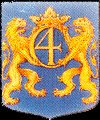 King Christians IV of Denmark, the founder of Kristiastad, gave Kristianstad its coat of arms in 1622. The coat of arms consists of two golden lions holding the crowned monogram of Christian IV between each other on a blue background. The town kept the coat of arms when Kristianstad became Swedish at the peace of Roskilde in 1658 and is supposedly today the only city/town in the world that has the monogram of a foreign monarch in its coat of arms.
King Christians IV of Denmark, the founder of Kristiastad, gave Kristianstad its coat of arms in 1622. The coat of arms consists of two golden lions holding the crowned monogram of Christian IV between each other on a blue background. The town kept the coat of arms when Kristianstad became Swedish at the peace of Roskilde in 1658 and is supposedly today the only city/town in the world that has the monogram of a foreign monarch in its coat of arms.
Maps of Krisitanstad
The left map shows the fortress Christainstad in the 1670s, the middle map is from 1807, when the fortress was at its largest, and the right map is over central Kristianstad today. North is to the right on all three maps.

History
During the Middle Ages, Skåne was a part of Denmark and the cities of Vä (= sacred place) and Åhus were both important centers for trade, religion, and royal power. However Denmark and Sweden were constantly involved in bitter battles. In February 1612, the infantry of the Swedish king Gustaf II Adolf razed Vä to the ground. The Danish King Christian IV (nicknamed “Christian the Great” in Denmark and “Christian the Tyrant” in Sweden) decided to build a new and more easily defended fortified city on the island of Allön, in the heart of the wetlands near the river Helgeå, instead of rebuilding Vä.
The town was founded on May 22, in 1614 and was named Christianstad (Christian's town) after the king, but today the towns name is spelled Kristianstad. The king revoked the city charters of Vä and Åhus and made the bourgeois move to the new city. The bourgeois disliked the position of the new city, because of the disease-causing marsh climate and the bad ground for building. Draining of the surrounding wetlands in the 1860s later solved the disease problems, but bad building ground is a big problem even in modern Kristianstad.
Kristianstad was for its time a very modern fortress, and it was the first important fortified town in Scandinavia that made full use of the Renaissance system of bastions. It is also one of few towns in the Nordic countries that are built on the basis of a decree on a place with no earlier settlements. These conditions gave Kristianstad its straight streets and right-angled city plan. The ramparts were leveled in 1847 to make way for Parisian-style boulevards and give the town room to expand. These streets are also named boulevards, just like in Paris, and have given Kristianstad the nickname "Lilla Paris"(= Little Paris). Today only portions of the northern moat are left. Kristianstad and Skåne became Swedish in 1658 at the Treaty of Roskilde, but this didn't create peace for Kristianstad. Snappharana, the feuding guerilla soldiers of the time, were fighting what they saw as the Swedish invaders for about 50 more years and during that time Danish troops captured the town twice.
“The most Danish town in Sweden”
Even though Kristianstad was only Danish for 44 years (1614-1658), its “Danishness” is still apparent and Christian IV makes his presence felt in many ways. For instance, the municipal coat of arms contains his name cipher "C4" and before 1898, when private banks had the right to issue banknotes, paper money from "Christianstads Enskilda Bank" bore the portrait and coat of arms of Christain IV - a Danish monarch on a Swedish banknote!
Transportation
Krisitianstad was a trading town, and barges used to sail through dredged channels from the port in Åhus, up until the water level fell after the Helgeå river created a new channel to the sea in 1775. In 1865 the first railway line was opened, and when the railways were at their peak, seven different lines radiated from Kritianstad. Although many of those railway lines have closed, Kristianstad still has a good connection to Lund, Malmö, and Copenhagen. A small airport is situated in Everöd, just outside Kristiantad. "Food Capital of Sweden” The land around Kristianstad is good for farming, which combined with a clean environment, specialist skills, and top food manufacturers make Kristianstad the food capital of Sweden. Each week every Swede probably consumes at least one product from Kristianstad.
Kristianstad’s Coat of Arms

 King Christians IV of Denmark, the founder of Kristiastad, gave Kristianstad its coat of arms in 1622. The coat of arms consists of two golden lions holding the crowned monogram of Christian IV between each other on a blue background. The town kept the coat of arms when Kristianstad became Swedish at the peace of Roskilde in 1658 and is supposedly today the only city/town in the world that has the monogram of a foreign monarch in its coat of arms.
King Christians IV of Denmark, the founder of Kristiastad, gave Kristianstad its coat of arms in 1622. The coat of arms consists of two golden lions holding the crowned monogram of Christian IV between each other on a blue background. The town kept the coat of arms when Kristianstad became Swedish at the peace of Roskilde in 1658 and is supposedly today the only city/town in the world that has the monogram of a foreign monarch in its coat of arms.Maps of Krisitanstad
The left map shows the fortress Christainstad in the 1670s, the middle map is from 1807, when the fortress was at its largest, and the right map is over central Kristianstad today. North is to the right on all three maps.

Tove's Walking Tour of Kristianstad (Sweden)
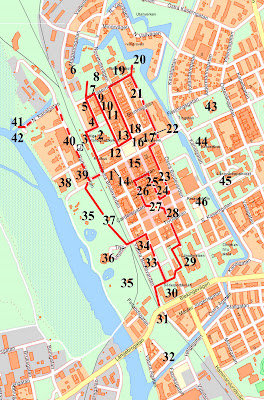
1. The former bank - Hotel C4 (V Boulevarden 15)
 The hotel First Hotel Christian IV, or Hotel C4 for short, is located in the "old savings bank" voted Kristianstad's most beautiful building during the Year of Architecture in 2001. Today you find the wine cellar in the former bank vault. The building dating from 1901, was built by “Sparbanken i Christianstad” (The savings bank in Christianstad) in German renascence and the architect O. Hägg from the firm Lindvall & Boklund in Malmö designed it. Originally the building housed the post office, the savings bank, and apartments. The post office moved out in 1917 and the bank in 1970. After the savings bank moved out, the building was used as a tourist office for a while before it was turned in to a hotel in 1986.
The hotel First Hotel Christian IV, or Hotel C4 for short, is located in the "old savings bank" voted Kristianstad's most beautiful building during the Year of Architecture in 2001. Today you find the wine cellar in the former bank vault. The building dating from 1901, was built by “Sparbanken i Christianstad” (The savings bank in Christianstad) in German renascence and the architect O. Hägg from the firm Lindvall & Boklund in Malmö designed it. Originally the building housed the post office, the savings bank, and apartments. The post office moved out in 1917 and the bank in 1970. After the savings bank moved out, the building was used as a tourist office for a while before it was turned in to a hotel in 1986.2. Heliga trefaldighets kyrkan (The Holy Trinity Church)
 The Holy Trinity Church, designed by the Dutch Hans van Steenwinckel and built byChristian between 1617 and 1628, displays the royal monogram in many places. The 59 meter high tower was added in 1865. The benches in the church are as old as the church and all have their own woodcarvings. King Christian IV ordered the original organ of the church in 1619. Built by the German Johan Lorentz, the organ stood ready in 1631. Even though the organ has been rebuilt many times since then, the façade is still the original, and the original façade pipes are still in use.
The Holy Trinity Church, designed by the Dutch Hans van Steenwinckel and built byChristian between 1617 and 1628, displays the royal monogram in many places. The 59 meter high tower was added in 1865. The benches in the church are as old as the church and all have their own woodcarvings. King Christian IV ordered the original organ of the church in 1619. Built by the German Johan Lorentz, the organ stood ready in 1631. Even though the organ has been rebuilt many times since then, the façade is still the original, and the original façade pipes are still in use.3. The Railway Station
 Kristianstad railway station, designed by Claes Adelsköld, was built in 1865. The Station building was extended with the main hall, designed by Per lenart Håkanson to the north in
Kristianstad railway station, designed by Claes Adelsköld, was built in 1865. The Station building was extended with the main hall, designed by Per lenart Håkanson to the north in1917.
4. Hotell Hertigen (Hotel The Duke) / The old school
Christian IV decided that there should be a school north of the Church. A school building was moved there from Åhus and was in use by the beginning of 1617. The building was also used as temporary church before completion of the proper one. In 1686, the old school house was exchanged for a new one.
 In 1835 it was time for a new and larger school building, and the school was now named “Hertig Carls Skola” (“Duke Carl’s School”). The same year the school headmaster, Per Johan Böklin, added classes for younger children to the school. Earlier the school was mainly for older children and the subjects was Latin, Greek, Hebrew, and religion. Shortly thereafter, the headmaster opened the school for the apprentices in the town to learn how to read and write on Saturdays and in evenings (probably for the first time in Sweden). In 1875 the school was moved to a new larger building in the southern parts of town. The school building was transformed into a hotel and tavern between 1877 and 1878, and today
In 1835 it was time for a new and larger school building, and the school was now named “Hertig Carls Skola” (“Duke Carl’s School”). The same year the school headmaster, Per Johan Böklin, added classes for younger children to the school. Earlier the school was mainly for older children and the subjects was Latin, Greek, Hebrew, and religion. Shortly thereafter, the headmaster opened the school for the apprentices in the town to learn how to read and write on Saturdays and in evenings (probably for the first time in Sweden). In 1875 the school was moved to a new larger building in the southern parts of town. The school building was transformed into a hotel and tavern between 1877 and 1878, and todaythe hotel is called “Hotell Hertigen” (“Hotel the Duke”).
5. Thalia Tempel (Thalia Temple)
 In the fall of 1833, a new theater opened in a building designed by Fredrik Blom, and the theater was open until 1903. After that the building has housed a dairy, a bakery, an architect firm, and apartments.
In the fall of 1833, a new theater opened in a building designed by Fredrik Blom, and the theater was open until 1903. After that the building has housed a dairy, a bakery, an architect firm, and apartments.6. Vattentornet (The water tower)

Historically the quality of the drinking water in Kristianastad has been at best questionable since the water was taken from the surrounding swamp, the moat, and Helgeå (Helge river) that also was used as outlet for the sewage system. This changed in 1939 when the first deep well was drilled, and since then the water has been taken from the ground water. The water tower that you see today is designed by Kjessler & Mannerstråle AB and has an indoor deck at the top where you can look out over Kristianstad and its surroundings. It was taken into use in 1965.
 7. North Town Gate (Norreport)
7. North Town Gate (Norreport)Carl Hårleman's original design for the northern entrance through the battlements was massive and thirteen meters in depth. The gate was taken down in 1900 and rebuilt on its
8. Norra Kassern (The North Barracks)
Norra Kassern (The North Barrack) was built between 1755 and 1767 as a barrack for the town guard, but was later taken over by Kungliga Wendes artilleriregementet (The Royal Wendes Artillery Regiment). The building was a military barrack until 1946, and today the regional museum uses it for storage, preservation, and restoration of its collections.
 In 1801, a guardhouse, called Fyrkappan, was built close to the north barrack for the guards of the north gate. The building was taken over by the city in 1967 and has been used as an office for the regional museum since 1978. Gula förådet (The Yellow Storage Building) is a yellow half-timbered storage building built for the field artillery around 1860. Taken over by the city in 1967, it is today used for adult education. Winter stables and a brick riding-house were built in 1897. The riding house has been used for storage by the regional museum since the 1970s, while the winter stables have been used for education since 1963.
In 1801, a guardhouse, called Fyrkappan, was built close to the north barrack for the guards of the north gate. The building was taken over by the city in 1967 and has been used as an office for the regional museum since 1978. Gula förådet (The Yellow Storage Building) is a yellow half-timbered storage building built for the field artillery around 1860. Taken over by the city in 1967, it is today used for adult education. Winter stables and a brick riding-house were built in 1897. The riding house has been used for storage by the regional museum since the 1970s, while the winter stables have been used for education since 1963.9. The old Salvation Army Citadel
 In this building from the 1760s, conspirators once plotted the only attempted political revolution in Swedish history. Johan Chritsopher Toll and a battalion from Prince Fredrik Adolf Regiment pledged themselves to the coup d'état against King Gustav III planned for 12 August 1772. However, nothing came of their plans. The name of the building comes from that the Salvation Army bought it in 1911 and owned and used it until 1999.
In this building from the 1760s, conspirators once plotted the only attempted political revolution in Swedish history. Johan Chritsopher Toll and a battalion from Prince Fredrik Adolf Regiment pledged themselves to the coup d'état against King Gustav III planned for 12 August 1772. However, nothing came of their plans. The name of the building comes from that the Salvation Army bought it in 1911 and owned and used it until 1999.10. The Prytz Tenement

Built by the military engineer Hans Prytz in 1641, this is one of Kristianstads oldest preserved
tenements. The reverently restored house contains a mural from the 17th century. A copy of the mural is kept in the Regional museum.
11. The Fortification Brigade Building
 Built in 1630s as a cobbler's shop, but the inscription is from the mid 1700s when the building had become a tavern and translates "Moderate pleasure, drink in measure, here enjoy at your own leisure". At the end of the 18th century, the building was the residence of the commanding officer of the Skåne fortification brigade and it was the Court of Appeal between 1821 and 1840. Today it houses administrative offices.
Built in 1630s as a cobbler's shop, but the inscription is from the mid 1700s when the building had become a tavern and translates "Moderate pleasure, drink in measure, here enjoy at your own leisure". At the end of the 18th century, the building was the residence of the commanding officer of the Skåne fortification brigade and it was the Court of Appeal between 1821 and 1840. Today it houses administrative offices.12. The Town Hall – Rådhuset
 Built in 1891, at the main square “Stora Torg” (“The Large Square”) on the site of an older town hall in emulation of Christian IV's Renaissance style. The inscription in Latin on the façade - PAX VOBIS ("Peace be with you") - was the king's greeting to the people of Kristianstad. In a niche, one can see a bronze statue by Bertel Thorvaldsen of Christian IV. In the foreground of the picture (just behind the middle car) you can see the Ikaros fountain.
Built in 1891, at the main square “Stora Torg” (“The Large Square”) on the site of an older town hall in emulation of Christian IV's Renaissance style. The inscription in Latin on the façade - PAX VOBIS ("Peace be with you") - was the king's greeting to the people of Kristianstad. In a niche, one can see a bronze statue by Bertel Thorvaldsen of Christian IV. In the foreground of the picture (just behind the middle car) you can see the Ikaros fountain.This was where TNT became husband and wife on November 30, 2005.
13. Kronohuset

Built in late classicism Empire style, 1840-41, this building was shared by the Court of Appeal and Wendes Artillery Regiment, hence the inscription LEGIBUS ET ARMIS ("With Laws and Arms"). Since the court moved to Malmö in 1917, the building has been used exclusively for military purposes.
14. Krisitanstadsbladet (The local newspaper)
 The local newspaper is called “Kristianstadsbladet” and it celebrated its 150th birthday in September 2006. The main office of the newspaper can be found in the corner of Nya Boulevarden and Västra Vallgatan
The local newspaper is called “Kristianstadsbladet” and it celebrated its 150th birthday in September 2006. The main office of the newspaper can be found in the corner of Nya Boulevarden and Västra Vallgatan15. Frimurarhuset (Freemansons' House)
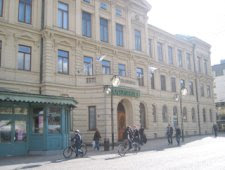 Another Renaissance style building is the building of the current Masonic lodge inaugurated by King Oscar II of Sweden in 1884. The first Masonic lodge in Kristianstad was founded in 1776. Today the building also houses a hotel, restaurant, and bar: Stadshotellet (The City Hotel).
Another Renaissance style building is the building of the current Masonic lodge inaugurated by King Oscar II of Sweden in 1884. The first Masonic lodge in Kristianstad was founded in 1776. Today the building also houses a hotel, restaurant, and bar: Stadshotellet (The City Hotel).16. The old post office and The Riksbank
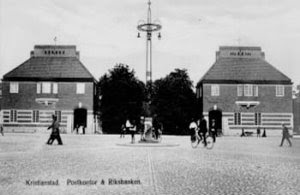 The right building was built in 1915 to house Sveriges Riksbank. In that spot today, you will find a restaurant and bar called Banken (“The bank”). The left building was built to contain the town’s main post office and stood ready in 1917. Since 2001 the building is part of the regional museum and house a center for contemporary art. The architect Erik Lallerstedt, Stockholm, designed both buildings.
The right building was built in 1915 to house Sveriges Riksbank. In that spot today, you will find a restaurant and bar called Banken (“The bank”). The left building was built to contain the town’s main post office and stood ready in 1917. Since 2001 the building is part of the regional museum and house a center for contemporary art. The architect Erik Lallerstedt, Stockholm, designed both buildings.17. The Regional Museum
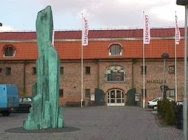 This building was built as the stables of Christian IV's palace in the 17th century, but the rest of the palace was never built, and after a decade or so the building was converted into an arsenal. It got its present appearance in the 1780's and became a museum in 1959. Today you can among other things find the history of Kristianstad, a section of military history, and a textile collection in the museum. Opening hours for the regional museum and center for contemporary art: Tuesday – Sunday 12-17. Admission: free
This building was built as the stables of Christian IV's palace in the 17th century, but the rest of the palace was never built, and after a decade or so the building was converted into an arsenal. It got its present appearance in the 1780's and became a museum in 1959. Today you can among other things find the history of Kristianstad, a section of military history, and a textile collection in the museum. Opening hours for the regional museum and center for contemporary art: Tuesday – Sunday 12-17. Admission: free18. Borgmästatgården (The Mayor's Residence)
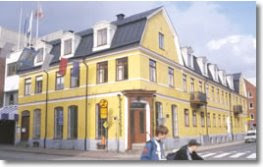 Mayor Jörgen Hansen built this building when Kristianstad was founded. The date 1640 on the façade records the time of the addition of the second floor. Its current appearance dates from the nineteenth century. General George Carl von Döbeln lived in the building 1811 - 12 while organizing the Northern Skåne infantry regiment, of which he was the first commanding officer.
Mayor Jörgen Hansen built this building when Kristianstad was founded. The date 1640 on the façade records the time of the addition of the second floor. Its current appearance dates from the nineteenth century. General George Carl von Döbeln lived in the building 1811 - 12 while organizing the Northern Skåne infantry regiment, of which he was the first commanding officer.19. Norretullskolan (“North Customs School”)
In 1863, it was decided to build “Norra Folkskolan” (“The North People School” ≈ The North Basic School). The first two-floor building of the school, designed by Måns Holmgren, was ready in 1867. In 1872, a third floor was added. In 1902 a smaller building, designed by August W. Lindvall, was added next to “Norra Folkskolan” to house “J H Dahls flickskola” (J H Dahl’s girls school).
 In 1942 the two schools became one with the name Praktiska Realskolan (≈ The Practical Middle School). In 1963 a new one-story building was added to the school. South of the “Norra Folkskolan” the military built a barrack, desigened by Erik Josephson, in 1900. The barrack was taken over by the municipal in 1958. After that you could find the company Johansson Textil in the building, before it was turned in to a school building. In 1969, Sweden implemented a new school system with a 9-year compulsory school before Gymnasiet (≈ High School). At this time “Norretullskolan” (“North Customs School”) became a “högstadeskola” (grade 7 to 9) and today you will find grade 6 to 9 here. In 1970, the school received a modern sports hall on the former spot of the North City gate.
In 1942 the two schools became one with the name Praktiska Realskolan (≈ The Practical Middle School). In 1963 a new one-story building was added to the school. South of the “Norra Folkskolan” the military built a barrack, desigened by Erik Josephson, in 1900. The barrack was taken over by the municipal in 1958. After that you could find the company Johansson Textil in the building, before it was turned in to a school building. In 1969, Sweden implemented a new school system with a 9-year compulsory school before Gymnasiet (≈ High School). At this time “Norretullskolan” (“North Customs School”) became a “högstadeskola” (grade 7 to 9) and today you will find grade 6 to 9 here. In 1970, the school received a modern sports hall on the former spot of the North City gate.20. Bastionen Konungen (The Bastion “The King”)
The Bastion “The King” has been recreated on the location it occupied between the seventeenth and nineteenth centuries.
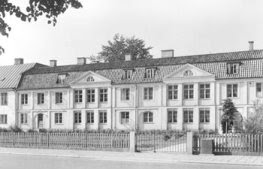
21. Österbergska gården (The House of Österberg)
Österbergska gården (The House of Österberg) was built between 1800 and 1840, by Lars Österberg and stayed in his family 1947. Today the buildings contain apartments.
22. Söderport (South gate)

The South gate of the old fortress was moved to its current position behind the regional museum in 1916.
23. Vähusen (The Vä Houses)
Some of the oldest and most interesting
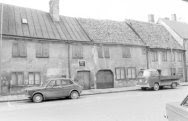 examples of Kristianstad's architectural heritage are the so-called Vähusen (The Vä Houses) on Östra Vallgatan, dating from the 1760s and renovated in 1980-81.
examples of Kristianstad's architectural heritage are the so-called Vähusen (The Vä Houses) on Östra Vallgatan, dating from the 1760s and renovated in 1980-81.24. Hennes & Mauritz huset (The H&M House)
 In the 17th and 18th century, you could find the inn in Kriaitianstad here, but today it is the H&M store in Kristianstad. If you enter the store you will find an 18th century (or possibly 17th century) facade inside the store. This is the old facade that used to face the yard that all buildings in Kristianstad used to have, and some still do. Since they are not allowed to remove the facade they had to build around it, but after a remodeling of the store in the 1990s it became part of the store decoration.
In the 17th and 18th century, you could find the inn in Kriaitianstad here, but today it is the H&M store in Kristianstad. If you enter the store you will find an 18th century (or possibly 17th century) facade inside the store. This is the old facade that used to face the yard that all buildings in Kristianstad used to have, and some still do. Since they are not allowed to remove the facade they had to build around it, but after a remodeling of the store in the 1990s it became part of the store decoration.25. The Film Museum
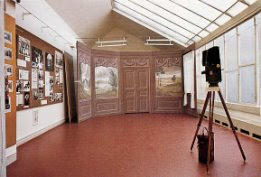 The Swedish film industry was born in Kristianstad. The museum is housed in the oldest film studio (1909-11) still standing in Sweden. There was also a small cinema here, the "Cosmorama". In, 2000 this was resurrected as the Kosmorama, with 4 screens for around 400 guests in a new location on Östra Boulevarden. The old film studio and the museum can be found on Östra Storgatan 53. In the museum today you will find a stage setting from 1910, costumes, props and a small movie theater that shows old films from the museum collection.
The Swedish film industry was born in Kristianstad. The museum is housed in the oldest film studio (1909-11) still standing in Sweden. There was also a small cinema here, the "Cosmorama". In, 2000 this was resurrected as the Kosmorama, with 4 screens for around 400 guests in a new location on Östra Boulevarden. The old film studio and the museum can be found on Östra Storgatan 53. In the museum today you will find a stage setting from 1910, costumes, props and a small movie theater that shows old films from the museum collection.Opening hours: Sunday 12 p.m. - 5 p.m.
26. Kungshuset (The King's House)
 The house at Västra Storgatan 39 was built in the 17th century. King Karl XII (1682-1718) of Sweden stayed in the house once, but the house got its name from another king, the exiled Polish King, Stanislaus Leszczynski. Stanislaus Leszczynski, and his retinue lived here between 1711 and 1714. His daughter Maria later became the queen of France. Today it houses a shopping center.
The house at Västra Storgatan 39 was built in the 17th century. King Karl XII (1682-1718) of Sweden stayed in the house once, but the house got its name from another king, the exiled Polish King, Stanislaus Leszczynski. Stanislaus Leszczynski, and his retinue lived here between 1711 and 1714. His daughter Maria later became the queen of France. Today it houses a shopping center.27. Lilla Torg (“The Small Square”)
Lilla Torg (“The Small Square”), earlier called Hästtorget (“The Horse Square”), was in the beginning of Krisitanstad a marketplace. Today, it is the center of the shopping area, where you will find open stands on the square with fruits, vegetables, and flowers all year. The small bell tower in the middle of the square is from the 1992 and is designed by Sune Friström and Ingemar Hertzman
28. Garvaregården (”The tanning farm”)
Garvaregården (”The tanning farm”) is a half-timbered house from the 17th century that used to be a tanning workshop. Today the building houses a restaurant.
29. Södra Kasern (South Barracks)
Södra Kasern Etablissemanget was used by Wendes artilleriregemente (Wendes Artillery Regiment) and the first barrack, Södra Kassern (The South Barrack) later called Gamla Södra Kassern (The Old South Barrack), was ready in 1793. In 1847, a second floor was added to the original one-story building. When the military moved out of the building in 1947, it was remodeled as an office building. Today you find a restaurant and a gallery in the basement. Between 1855 and 1865 summer stables where built in southwest and southeast of the military ground, both summer stables are gone except for the outer wall of the east stables that now serves as a wall towards the street. A plastered, half-timbered storage building, Blomska Förrådet (The Blomska Storage Building) was built between the two summer stables, and stood ready in 1871. Today you find offices of Länstyrelsen (the county board) and the Red Cross in the building. A riding house was built along the south east side of the area in 1876. The riding house was turned in to a sports hall in 1947 and became the dining hall of Söderportskolan (The South Gate School) next door in 1994. In 1897, a new three-storey barrack, Nya Södra Kasern (New South Barrack), was build a bit to the east of the Old South Barrack. After the military left the building, it has been used by the university and adult education.
30. Söderportskolan (South Gate School)
In 1871, it was decided to build a new larger school on the place where the south gate had stood and the new school opened in 1875. The original building drawn by the architect J.A. Haverman had two floors with three floors in the middle and a clock tower on the top. A wing was added in 1901, a third floor in 1915, and in the 1930s it was extend both to the east and west. The assembly hall next to V. Bolevarden was built after a large fire in 1959. In 1968, the school received its current name “Söderportskolan” (“The south gate school”) or “Söderportgymnasiet” (“The South Gate High School”) when the new gymnasiskola (≈ High
School) was created in Sweden. The same year the natural science and technical program was moved to a newly built school, Österängskolan (“The East Field School”) or Östrängsgymnasiet (“The East Field High School”) a bit outside the central part of Kristianstad. Today Kristianstad has two additional High Schools, “Wendesskolan” (“Wende’s School”) and the culture High School “Christian IV’s Skola” (“Christian IV’s School”). However, “Söderportskolan” (“The south gate school”) and Österängskolan (“The East Field School”) are still the largest schools, and it is tradition for the two schools to make pranks on each other.
Tove went to Österängskolan (“The East Field School”), since that’s where you still find the
Natural Science program.
31. Skottenborg House
As old as Kristianstad, this little house was where the secretary of the Danish Royal Buildings
Works, Jens Rasmussen, had his office. Over the course of time, the little house has been used as a place to live, an office, a guardhouse, and a restaurant. Skottenborg is named after a mayor in the 1640s (Thomas Anders Skotte), and the house acquired its present appearance in the 1770s. Owned by the municipality, it today serves as the residence of the museum director.
32. Grönros Silversmiths
The silver smithy in Kristianstad is the oldest in Sweden and dates back to the 1680's. It was moved to its present location on the banks of the canal in 1915. The smithy has punches still in use from the 17th century, and you won’t find an equivalent collection of punches anywhere else in Europe. The current silver smith is Ingmar Grönros.
33. Länsresidenset (“The governor residence”)
Kristianstad became a residence town (home of the county’s governor) in 1719. When the county of Kristianstad joined with the county of Malmö on January 1, 1997 it stopped being a residence town, but it is still the home of the county board. During its time as a residence town, Kristianstad had 25 governors. The first lived at “Stora Torg” (The Large Square) and later at “Lilla Torg” (The Small Square). The last residence stood ready on December 28, 1860, and was designed in Italian renaissance by Fredrik Willhelm Scholander.The building contained the governor’s residence on the second floor and offices on the first.
34. The Old Town Hall
A building in Renaissance-inspired 19th century architecture that for many years served as the most prestigious rendezvous for Kristianstad's high society. The impressive staircase under the gigantic crystal chandelier leads up to assembly rooms for 500 people.
35. Tivioliparken (The Tivoli Park)
The Tivoli Park, that got its name from Tivoli in Copenhagen, was once an area used to drill the soldiers. During the mid 19th century the field slowly turned in to a public park. The park was taken over by the town in 1901 and is today a green oasis close to the town center.
36. The Tivoli Park Theater
Designed by architect Axel Anderberg from Kristianstad, who also designed Stockholm Opera House and the Oscar Theater, the theater was built in art nouveau style in 1906 to replace the old Thalia Temple that had stood in the northern part of town from 1833.
37. Fornstugan (The History House) in the Tivoli Park
One of the oldest museum buildings in Sweden built in 1886, in the idealized Viking style of Sweden's "National Romantic" movement. It was a museum between 1886 and 1913. Today it houses a summer café from May to September.
38. Badhuset (The Public Bath)
The Public Bath in Krisitianstad can be found on top what used to be a harbor. In 1953, the
project to transform the harbor into land started, and the public bath was opened in the fall of
1957. The building designed by architect SAR Robert Larsson, Kristianstad contained a 25 meter pool with six lanes and diving boards of one, there, and, five meters in height. In 1994 the public pool house was remodeled and a new 25-meter pool with eight lanes, a Jacuzzi and a smaller warm water pool was added. The public bath now got the name “Tivoli Badet” (“The Tivoli Bath”) and a new sign was put up in addition to the old one. The new pool is used for swimming while the old is used for play. The 5-meter diving board was removed during the remodeling but a small water slide and a “climbing wall” that can be lowered in to the pool was added. In 2006, a building with a gym was added to the public bath.
This was for many years the second home of our family, since both Tove and her brother Erik
were swimming.
39. Kulturhuset Barbacka (The Culture Center Barbacka)
The culture center started in the beginning of the 1990s, and mainly provides cultural activities for youth and children.
40. Kvarnen (The Mill)
Although today it is an office building with a restaurant on the ground floor, the Kvarnen (“The Mill”) kept its historical name, since it used to be a roller mill that closed in 1991. The first part of the building was built in 1893, and the building got its current appearance in 1949.
41. Kristianstads Vattenrike (the rich wetlands of Kristianstad)
Kristianstads Vattenrike (the rich wetlands of Kristianstad, or directly translated “Kristianstad’s Water Kingdom”) is the name of the wetlands around Kristianstad, rich in plant and animal life. The area has been accorded the status of a so-called “Ramsar Convention site” as an area of international significance, worthy of conservation by UNESCO and is the nesting ground for several endangered birds. The area also contains the largest reserves of groundwater in northern Europe. Kristianstads Vattenrike is an out door eco-museum with 13 information stations at different positions in the area, each dealing with different aspects of the general theme of water.
42. The Linnérundan trail
The Linnérundan trail that starts by the Canal House, one of the 13 information stations in Kristianstads Vattenrike and an Outdoor Museum, north of the public bath. The trail that leads to Lillö Castle is a part of a system of paths that links urban Kristianstad with the wetlands. It takes name from the famous botanist Carls von Linné who visited the wetlands surrounding the city on his journey in 1749.
Lillö Castle:
Lillö Castle, from the 14th century, was built on the edge of the marshy wetlands. It was during a visit to the castle that Christian IV decided where to build his new city, Christianstad. The castle was mostly blown to pieces during the seventeenth century, but following excavations in the 1940s, the ruins are now there for all to see. You can borrow the key to the castle from the tourist information (phone: +46-44-135335)
Härlöv Castle:
This mound, which you pass when you walk the Linnérundan trail, is known as Härlöv Castle. In the Middle Ages, this was the site of a wooden stockade and later, during the “Scanian War” with Denmark (1675–1679), a redoubt was built on top of the old castle.
43. Kristianstad Centrum Prison
The prison “Kristianstad Centrum” was the first building to be built outside the fortifications, in 1846. The prison is one of the oldest still in use in Sweden.
44. Konserthuset (”The Concert House”)
Konserthuset (”The Concert House”) in Kristianstad opened in 1936 and contains two Concert halls. The building was designed by P L Håkansson.
45. Gamla sjukhus området (The old hospital area)
Kristianstad’s first hospital had two beds and opened in 1776. A new hospital with 70 beds was built between 1807 and 1833. The hospital was extended to 188 beds in 1909, and to 350 beds in 1930. The hospital area was turned in to apartments after the construction of a new modern hospital further away from the center in 1973. The new hospital is by far the largest building in Kristianstad today.
46. Resecentrum (The travel center)
This is the central bus station. Some busses but not all also stop by the Train station. In the travel center you’ll also find an information desk for the public busses. City busses are green, while countryside busses and “Skåne Express” busses are yellow.
Kristianstad Högskola (Kristianstad University)
Is a small university established in 1977, but the teaching college is from 1835. The University
moved to its current location in Näsby outside the central part of Kristianstad in 1995. In 1998, the nursing college, started in 1893, joined the university. The university today has 6 departments and about 11 000 students, half of which are full time students.
Subscribe to:
Posts (Atom)







